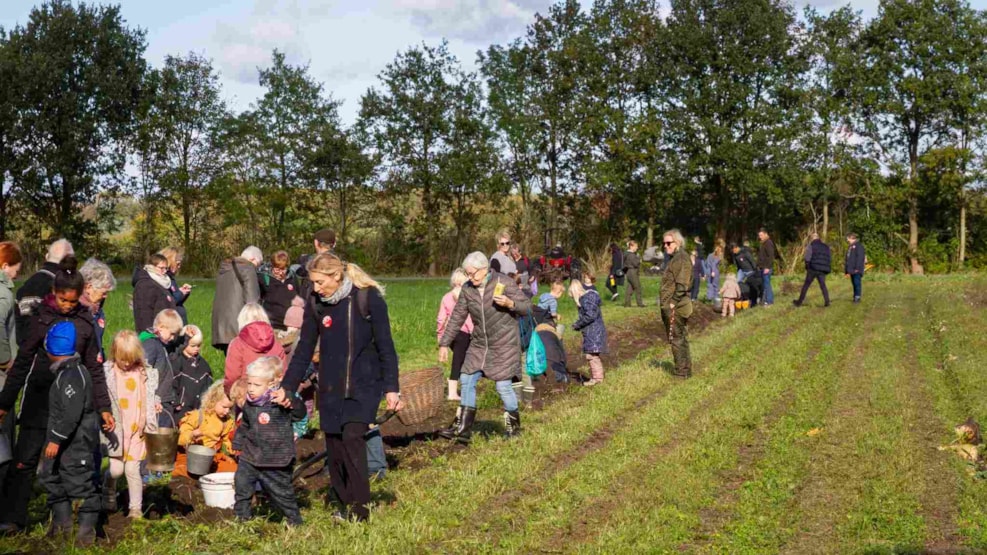
The Outline for the Landscape
In 1864, Denmark lost the rich duchies of Schleswig and Holstein to the Germans. The country’s area shrank dramatically, and the number of citizens was halved.
Large portions of the best agricultural land were lost. The defeat called for self-reflection and a new Danish national consciousness. The motto "What is lost outwardly must be won inwardly" resonated. Thus, the large uncultivated areas in Jutland came into focus, and the cultivation of the heath truly began.
From Superstition to Overconfidence
In the mid-1800s, humanity was in a major paradigm shift in history. The Enlightenment laid the groundwork for a break with old dogmas, monarchy, and the church. With industrialization, we accelerated the development of modern society, where nature was subjected to human striving for profit. Natural science surpassed the church's monopoly on truth. Reason, freedom, and progress became the mantras of the time.
In the second half of the 1700s, the Danish state implemented a series of land reforms. The aim was to increase agricultural production. The traditional village community was broken up. The tenant farmer was (slowly) freed. With a ruler as the most important tool, new land distributions were created. The many small plots cultivated by a village farmer were consolidated into one or a few fields. The common grazing areas were included in the redistribution. New fences were erected. The traditional cyclical agriculture had to make way for progress. New winds were blowing.
From Expansive Heath to Shelterbelts
Large parts of Jutland were covered in heath in the 1700s. There were a few farmers who managed to make a living from cultivating heathland. However, heath farmers needed several hundred acres and various side jobs to get by. They were few and lived by the terms of the heath.
Several kings had looked at the heath to see if the extensive areas could benefit the country. For example, Frederick 5. lured about 1,000 farmers from Germany to the heath in 1758. Some dropped out, but others remained on the barren land. They cultivated potatoes, among other things, and were named accordingly.
However, it didn’t amount to much. Between 1830 and 1870, Denmark's agricultural area increased by only about 3%.
The loss of the duchies truly initiated the cultivation of the heath. However, several factors helped to get the upper hand in this effort:
- Farmers had better tools, allowing the poor land to yield acceptable returns—manure, better tools, and stronger horses.
- By planting shelterbelts—led by the Heath Society—sand drift was controlled, and better growth conditions were achieved.
- Agriculture shifted from primarily growing grain to raising animals—dairy cattle, beef cattle, pigs, and horses—providing manure for the fields.
With the Heath Society at the forefront, the landscape changed its appearance. From treeless expanses to parcels enclosed by shelterbelts laid out with mathematical precision. Plantations with trees in rows pulled after a ruler. Measures for drainage and regulation of waterways were implemented.
The plans succeeded. The heath originally covered about one-third of Jutland's area. By around 1950, only 2% remained.
Triumphantly, the Heath Society celebrated their victory with a verse:
“We have a tyrant from the west,
it is the storm,
it is the wind.
Only one advice against it we found:
Plant!”
—F. Jensen, Heath Society
Productivity increased steadily. However, nature disappeared.
The rise in agricultural productivity from 1864 and the following 50 years was impressive. The number of pigs increased fivefold. The cattle population grew by 100%. The number of horses tripled. Cows produced three times as much milk in 1914 as at the outset. Increasingly larger portions of the land came under the plow and were cultivated more intensively than ever before.
This trend has continued to the present day, where pigs have extra ribs to make room for a couple more chops per pig, and cows now produce ten times more than cows did in 1864.
In recent years, especially organic farming has gained ground with the idea of putting less pressure on animals, soil, and crops. At the same time, Danes are working to rectify some of the mistakes made during the cultivation of the heath—they are restoring wetlands and remeandering rivers. Danes are giving more space to nature year by year, partly by ceasing to cultivate marginal lands. This effort means that protected nature now unfolds over about 12% of Denmark's area. However, there is still a long way to go to the 28% protected nature that researchers recommend for Denmark.
In this case, the plans for the cultivation of the heath were fully realized. However, the result became problematic. The Danish farmers triumphed to hell.
If you want to know more, you can visit the exhibition "Humanity and Nature" at MARK – Museet for en ny Danmarkshistorie. Get a guided tour of the museum. And venture out onto the heath and imagine what the land looked like when the heath stretched as far as the eye could see.
Where Does the Heath Come From?
The heath landscape is paradoxically man-made. Paradoxical because in many places today people lament that they nearly eradicated the heath. For many years, Jutland was covered in forest, but the earlier farmers cleared the forests to cultivate grain and make room for grazing. This began as early as the Stone Age. But when nutrient-poor soils are pressed, sand drift occurs if they are not protected by forest. And then the heath can take over.